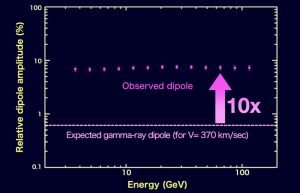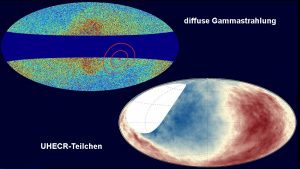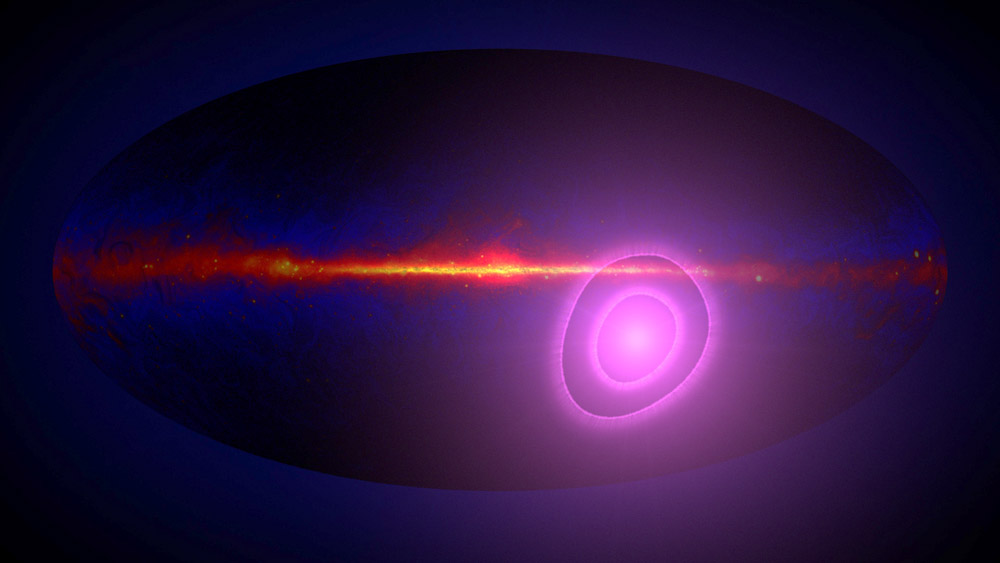Mysterious phenomenon: Astronomers have measured the cosmic gamma-ray background and discovered something surprising. Because the radiation shows an asymmetry that has not yet been explained. This so-called dipole is ten times stronger than it should be and its cause is unknown. However, the asymmetry is similar to the uneven distribution, which has also been measured in the most energetic charged particles of cosmic rays. But what lies behind it is unknown in either case.
The entire universe is filled with a faint, diffuse background of radiation and particles. Part of it consists of gamma radiation – scattered, high-energy radiation coming from distant quasars, supernovas or galaxies with strong star formation. However, how the diffuse gamma-ray background arises and what contribution different sources make to it have been only partially clarified so far. This is also because not all features of this cosmic gamma ray carpet have been identified yet.
Asymmetrically rather than evenly distributed
Now astronomers have mapped one of these missing features of the gamma-ray background – its spatial symmetry. To do this, a team led by Alexander Kashlinsky of NASA's Goddard Space Flight Center evaluated 13 years of data from the Fermi gamma-ray telescope. The radiation has been mapped in the energy range between three and 100 GeV. Astronomers have removed point sources and interference effects from our galaxy, so that only the scattered portion of the gamma-ray background remains.

The surprising result: Instead of the expected relatively equal distribution, there was a clear asymmetry – known in technical parlance as a dipole. “After ruling out all known sources, we found a dipole that is highly statistically significant and of extragalactic origin,” Kashlinski and his colleagues say. Specifically, they found that the background gamma radiation in one part of the southern sky is six to seven percent stronger than elsewhere.
Does not fit Dipol or CMB models
“This is an accidental and unexpected finding,” Kashlinski says. “The signal we found is much stronger and in a different part of the sky than we expected.” Astronomers discovered a dipole structure in the much longer wavelength microwave background (CMB) decades ago. The microwave radiation in the northwestern part of the sky is slightly hotter than the overall average. In an area located in the southeast of the sky, the weather is slightly cooler.
But the problem is that the gamma-ray asymmetry that has now been discovered does not match the microwave dipole in either its distribution or extent. “Our gamma dipole peak is a far cry from that found in the microwave background, and is 10 times stronger than we expected,” says co-author Chris Schrader of NASA. Even the distorting effect of our motion can only explain a small part of the gamma-ray asymmetry.

Amazing agreement with extreme cosmic particles
But where does this mysterious bipolar come from? So far, researchers don't have an answer. But what's exciting is that astronomers at the Pierre Auger Observatory in Argentina discovered a very similar, previously inexplicable dipole in the most energetic cosmic ray particles of 2017. These are rare but extremely high-energy particles charged at more than an exa-electron volt, Which are also known as UHECR (Ultra High Energy Cosmic Rays).
Although cosmic UHECR particles are billions of times more energetic than diffuse gamma rays, their asymmetry is similar: the dipole affects the same region of the sky and is also about the same amplitude, astronomers report. “This may indicate a common origin for UHECR and gamma-ray photons,” they explained. The only problem is that the source of the most energetic part of cosmic particles is still unknown.
Two phenomena, asymmetry, and many open questions
This means that astronomers now have two cosmological phenomena that exhibit a previously inexplicable asymmetry. But in either case, there are no conclusive insights into how and where they originate. To solve this puzzle, researchers must now either elucidate the sources of UHECR and gamma-ray propagation or develop theoretical models that shed light on possible physical mechanisms. This can help in the search for a bipolar origin. (The Astrophysical Journal Letters, 2024; doi: 10.3847/2041-8213/acfedd)
Source: NASA/Goddard Space Flight Center
January 15, 2024 – Nadia Podbrigar

“Total coffee aficionado. Travel buff. Music ninja. Bacon nerd. Beeraholic.”








More Stories
Coral Seeding: Artificial Insemination Makes Coral More Heat Tolerant
Fear, Anger, and Denial: How People Respond to Climate Change – Research
LKH Graz: Using radiation to combat heart arrhythmias